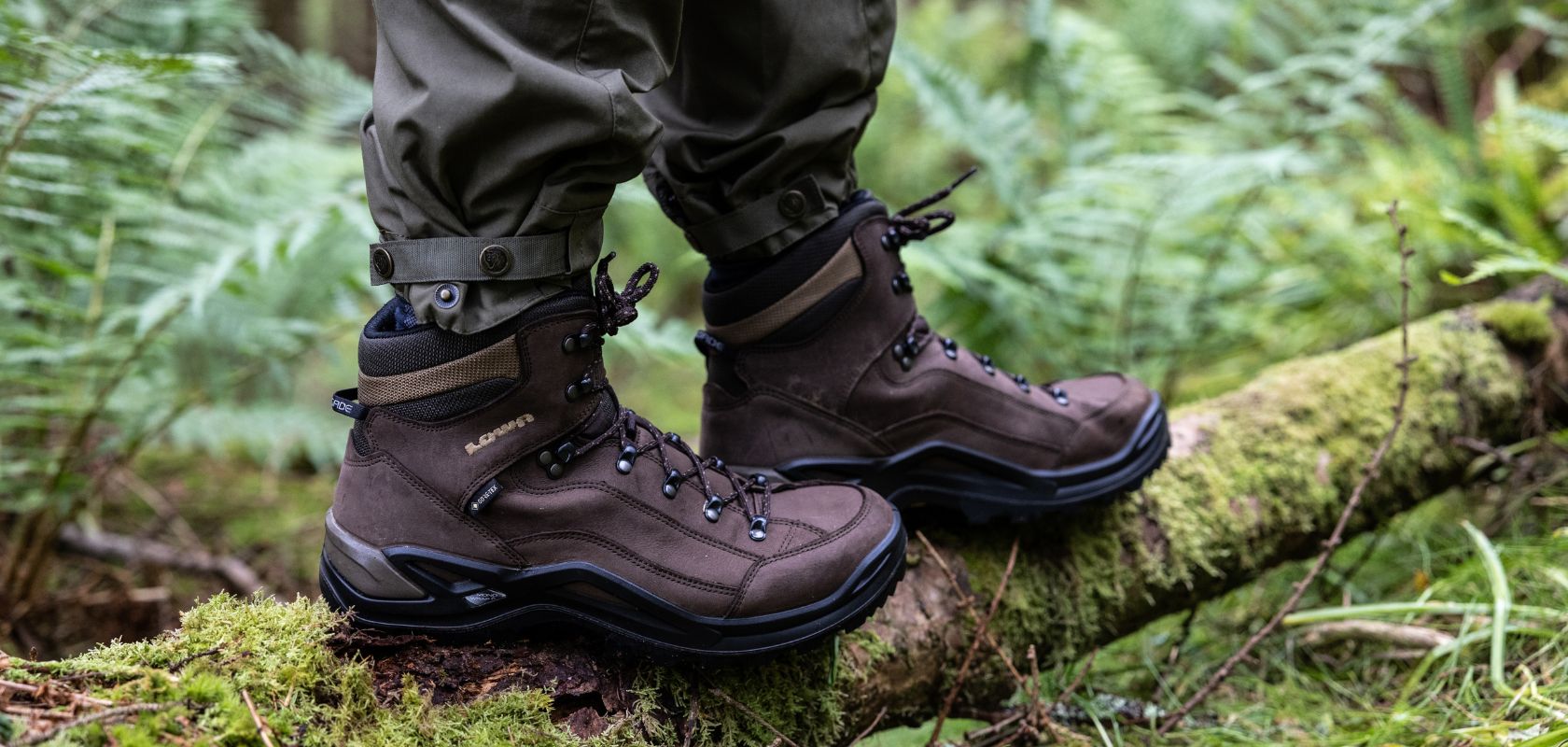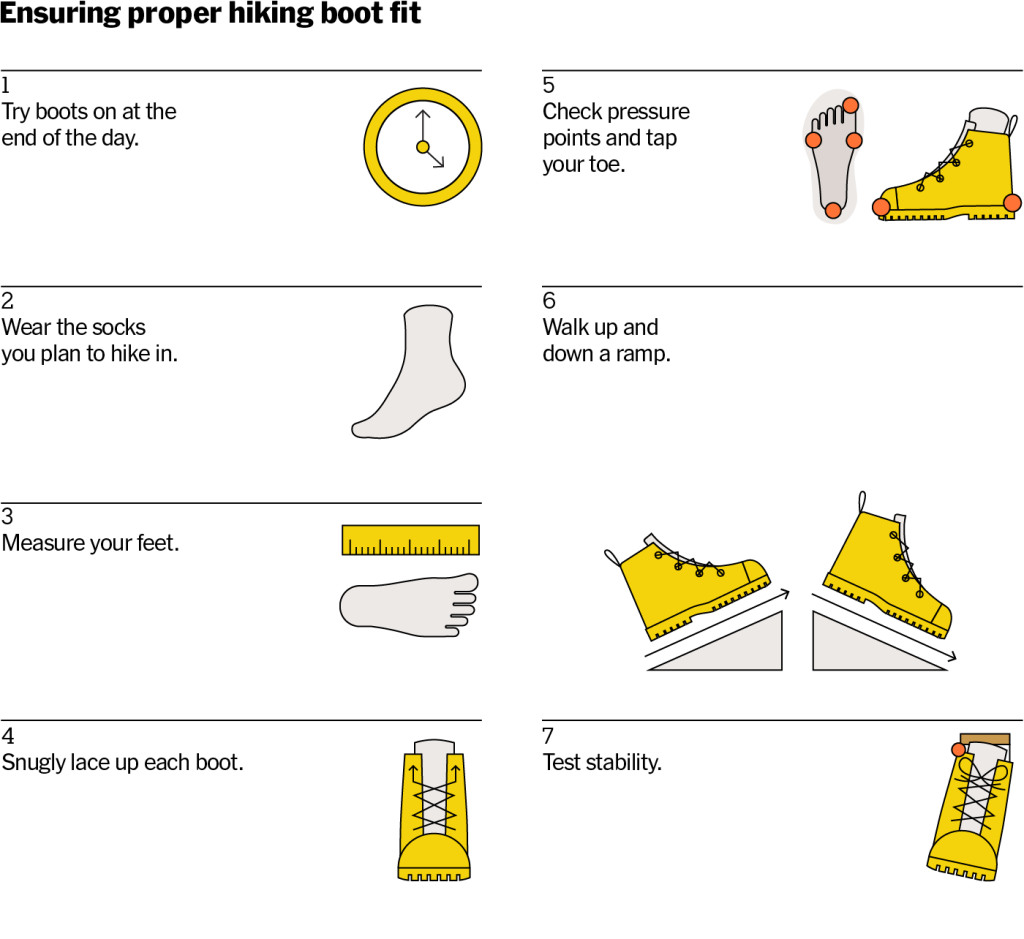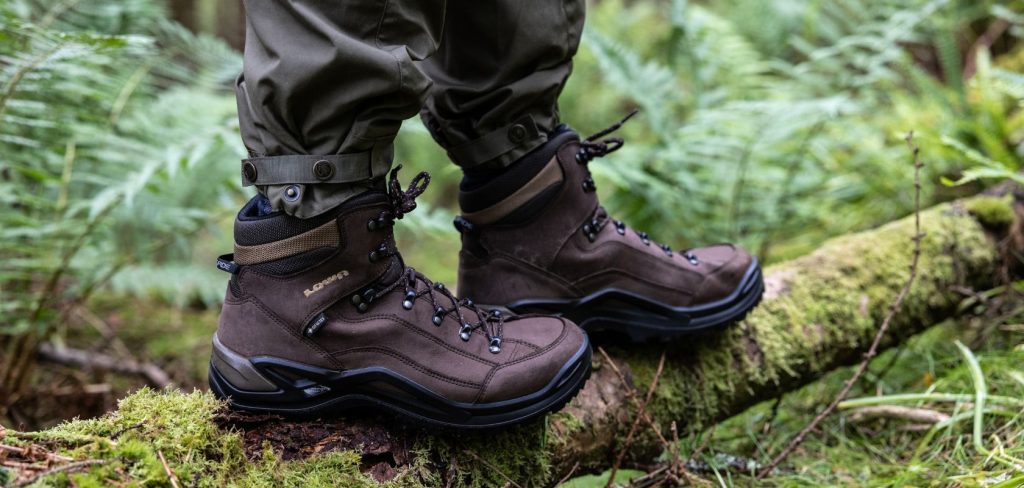
Have you ever gone hiking and ended up with blisters and sore feet? It might be because your hiking boots are not properly sized and fitted. But don’t worry, we’ve got you covered! In this article, we will guide you through the process of finding the perfect hiking boots that will provide comfort and support on all your outdoor adventures. So, let’s lace up and get started!
When it comes to sizing hiking boots, it’s important to consider both the length and width of your feet. You don’t want your toes constantly bumping against the front of the boots or feeling cramped on the sides. We’ll show you how to measure your feet accurately and determine the right size for you.
But sizing is just the first step. Properly fitting hiking boots should also provide ample support and cushioning to prevent any discomfort or injuries while on the trail. We’ll give you tips on how to test the fit of the boots, such as checking the heel snugness and arch support. Additionally, we will discuss the different types of hiking boots available, so you can choose the right style for your specific needs. By the end of this article, you’ll be well-equipped with the knowledge to find hiking boots that will keep your feet happy throughout your outdoor excursions.

This image is property of cdn.thewirecutter.com.
A Guide to Properly Sizing and Fitting Hiking Boots
Hiking is a popular outdoor activity that requires the right gear to ensure a comfortable and enjoyable experience. One of the most important pieces of equipment for any hiker is a pair of well-fitting hiking boots. Properly sizing and fitting hiking boots is essential for comfort, foot health, and overall hiking experience. In this guide, we will walk you through the process of finding the right size and fit, choosing the right style and type, understanding sizing systems, getting accurate measurements, trying on hiking boots, addressing specific fit concerns, breaking in hiking boots, buying online tips, the importance of professional fitting, and concluding with a summary of the key points.
Understanding Foot Measurements
Before embarking on your journey to find the perfect hiking boots, it is important to understand how foot measurements work. Feet come in a variety of shapes and sizes, and it is crucial to find a boot that accommodates your unique foot shape. Two key measurements to consider are length and width.
Length measurement is typically taken from the heel to the longest toe. To get an accurate length measurement, use a Brannock Device, a tool commonly found in shoe stores, which provides precise measurements for both length and width.
When it comes to width, it is important to find a boot that provides enough room for your toes to move freely without being constricted. A good rule of thumb is to ensure that there is a thumb’s width of space between the end of your longest toe and the front of the boot.
Considering Toe Room
Proper toe room is essential for hiking comfort. When your toes are cramped or constantly hitting the front of the boot, it can lead to discomfort and even blisters. As mentioned earlier, a thumb’s width of space between the end of your longest toe and the front of the boot is a good indicator of proper toe room.
It is also important to consider the shape of the toe box. Some hiking boots have a more rounded toe box, while others have a more tapered shape. Choose the one that suits your foot shape and provides enough room for your toes to move freely.
Ensuring Proper Arch Support
Arch support is another crucial factor when it comes to finding the right fit for hiking boots. The arch of your foot acts as a shock absorber while hiking, so it is important to choose boots that provide adequate support.
To determine your arch type, you can perform a simple “wet test.” Wet the sole of your foot and step on a piece of paper. The resulting footprint will show whether you have a high arch, low arch, or neutral arch. Once you know your arch type, look for boots that offer the appropriate level of support. Some boots have built-in arch support, while others allow for custom orthotic inserts to be added.
Checking for Proper Heel Fit
The heel is another area of the foot that requires proper fit and support. A well-fitting hiking boot should hold your heel securely in place without slipping or rubbing. If your heel slides up and down while walking, it can cause friction and blisters.
To check for proper heel fit, lace up the boots and walk around. The boot should feel snug around your heel, but not too tight. It should allow for a small amount of movement while still providing enough support to prevent heel slippage.
Choosing the Right Style and Type
Once you have determined your foot measurements and considered the fit for different areas of your foot, it is time to choose the right style and type of hiking boot. This decision will depend on the type of hiking you plan to do and the terrain you will be tackling.
Understanding Different Hiking Boot Styles
Hiking boots come in various styles, each catering to different hiking activities and conditions. The three main categories are lightweight hiking shoes, mid-cut boots, and high-cut boots.
-
Lightweight hiking shoes are ideal for day hikes on well-groomed trails. They provide comfort, flexibility, and breathability. These shoes are great for those who prefer a lighter and more agile hiking experience.
-
Mid-cut boots offer more ankle support and are suitable for a variety of hiking conditions. They provide stability and protection against rough terrains. These boots are perfect for day hikes or overnight trips with moderate pack loads.
-
High-cut boots, also known as backpacking boots, are the most robust and supportive option. They provide maximum ankle support and are suitable for multi-day hikes or backpacking adventures. These boots are designed to handle rugged terrains and heavier loads.
Considering the Terrain and Activity Level
The terrain and activity level are important factors to consider when choosing the right hiking boot type. If you will be hiking on well-maintained trails and engaging in light activities, such as day hikes or short walks, lightweight hiking shoes may be sufficient. However, if you plan to tackle more challenging terrains or carry heavy backpacks for extended periods, mid-cut or high-cut boots will provide the necessary support and protection.
It is also worth considering the climate and weather conditions of your hiking destination. If you frequently hike in wet or snowy environments, look for boots that are waterproof or have water-resistant features.
Selecting the Appropriate Hiking Boot Type
In addition to the different styles of hiking boots, there are also specific types of boots designed for different purposes. Some common types include hiking boots, backpacking boots, mountaineering boots, and trail running shoes. Each type has its own unique features and is suited for specific activities.
Hiking boots, as discussed earlier, are versatile and suitable for most hiking adventures. They provide a good balance of comfort, support, and durability. Backpacking boots are sturdier and offer more support for long-distance treks with heavier loads. Mountaineering boots are designed for extreme conditions and provide excellent insulation and traction. Trail running shoes are lightweight and perfect for those who prefer faster-paced hikes or trail running.
Choosing the right hiking boot type will depend on the activities you enjoy and the level of support and protection you need.

This image is property of cdn.snowys.com.au.
Understanding Sizing Systems
Now that we have covered the process of finding the right size and fit for your hiking boots, let’s dive into understanding sizing systems. Different countries and brands may use different sizing systems, so it is important to be familiar with the common ones.
Exploring the Brannock Device System
The Brannock Device system is widely used in the United States and provides a standard measurement for foot length and width. It is a metal foot-measuring device found in most shoe stores. The device has two movable arms that measure the length and width of a foot in inches and centimeters.
To determine your foot size using the Brannock Device, stand upright with your weight evenly distributed and place your foot on the device. Slide the movable arms until they touch the end of your longest toe and the widest part of your foot, respectively. Take note of the measurements and compare them to the size chart provided by the manufacturer.
Understanding European Shoe Sizing
European shoe sizing follows a different system than the Brannock Device. Instead of measuring foot length in inches or centimeters, it uses a numerical scale. The European shoe size is based on the length of the foot in Paris points, with each point corresponding to two-thirds of a centimeter.
To convert your foot length in inches or centimeters to European shoe size, consult a size conversion chart that provides the corresponding sizes.
Converting Between Different Sizing Systems
Converting between different sizing systems can be challenging, as there is no universally agreed-upon conversion. However, many online resources and size conversion charts can provide a rough estimate of how different sizing systems correspond to each other.
When buying online, make sure to check the sizing information provided by the manufacturer and refer to their size chart for accurate measurements.
Getting Accurate Measurements
Now that you are familiar with foot measurements and sizing systems, it’s time to make sure you get accurate measurements. Accurate measurements are crucial for finding the right size and fit, especially when shopping online.
Using a Brannock Device for Length Measurement
As mentioned earlier, the Brannock Device is a reliable tool for measuring foot length. If you don’t have access to a Brannock Device, you can use a ruler or tape measure to measure the length of your foot.
To measure foot length, place your heel against a wall and measure from the wall to the tip of your longest toe. Take note of the measurement and refer to the size chart provided by the manufacturer to determine the appropriate size.
Measuring Foot Width Correctly
To measure foot width accurately, use a measuring tape or ruler. Wrap the measuring tape or ruler around the widest part of your foot, typically around the ball of your foot. Take note of the measurement and compare it to the width measurements provided by the manufacturer.
It is important to note that foot width may differ between individuals, even if they have the same foot length. Some boots are available in different width options to accommodate the varying widths of feet.
Taking Into Account Foot Volume
Foot volume refers to the amount of space your foot occupies inside the boot. It is important to consider foot volume when choosing the right size and fit for hiking boots. If you have a higher volume foot, meaning your foot is thicker or bulkier, you may need to go up a size to accommodate the extra volume. On the other hand, if you have a lower volume foot, meaning your foot is slimmer or narrower, you may need to go down a size to ensure a snug fit.
When trying on boots, pay attention to any areas that feel tight or too loose. Ideally, the boot should provide a secure yet comfortable fit throughout the entire foot.

This image is property of cdn.shopify.com.
Trying On Hiking Boots
Now that you have gathered all the necessary information and measurements, it’s time to try on some hiking boots. Trying on boots is a crucial step in finding the right size and fit for your feet.
Wearing Appropriate Socks
When trying on hiking boots, it is important to wear the socks you would typically wear while hiking. Different socks can affect the fit of the boots, so it is important to replicate the actual hiking conditions as closely as possible. Wear socks that provide cushioning and moisture-wicking properties to keep your feet dry and comfortable.
Lacing Hiking Boots Properly
Lacing hiking boots correctly is essential for achieving the best fit and support. Improper lacing can lead to discomfort and even foot pain.
To lace your hiking boots properly, start by loosening the laces all the way up and then sliding your foot into the boot. Make sure your foot is positioned correctly, with your heel snugly in place. Begin lacing from the bottom, making sure each set of eyelets is tightened evenly. As you move up the boot, adjust the tension of the laces to ensure a secure yet comfortable fit. Finally, tie a double knot or use a lock-lacing technique to prevent the laces from coming undone during your hike.
Testing Fit and Comfort
Once you have laced up your boots, stand up, walk around, and test their fit and comfort. Pay attention to any areas that feel too tight, too loose, or cause discomfort. Bend your knees, walk up and down stairs, and simulate hiking movements to ensure that the boots provide enough flexibility and support for your activities.
It is essential to take the time to properly test the fit and comfort of the boots. Remember that the initial feel of the boots may differ from how they feel after a longer period of use.
Addressing Specific Fit Concerns
While hiking boots are designed to fit a wide range of feet, some individuals may have specific fit concerns that require additional attention. Here are some common fit concerns and how to address them.
Dealing with Wide Feet
If you have wide feet, it can be challenging to find boots that provide the necessary width without sacrificing length or toe room. Look for brands that offer wider options or consider models that come in different widths. Some boot manufacturers provide wide sizes to accommodate various foot shapes.
Another option is to consult with a professional boot fitter who can assess your feet and recommend boots that will provide the best fit for your width needs.
Finding Boots for High Arches
If you have high arches, it is important to find boots that offer proper arch support. Look for boots with built-in arch support or the ability to accommodate custom orthotic inserts. Custom orthotics can provide additional support and cushioning to alleviate discomfort associated with high arches.
Orthotic inserts can be purchased separately and inserted into your hiking boots to provide personalized arch support. It is best to consult with a foot specialist or boot fitter to ensure you choose the right type of orthotics for your needs.
Managing Hot Spots and Blisters
Hot spots and blisters are common issues when it comes to hiking boots. They can be caused by friction, pressure points, or improper fit.
To manage hot spots and blisters, it is important to address the root cause. Make sure your boots are properly fitted and laced to minimize any movement or friction. Consider using moleskin or blister prevention products to protect vulnerable areas of your feet.
If you frequently experience hot spots or blisters, consult with a foot specialist or boot fitter to assess the fit of your boots and recommend appropriate solutions.

This image is property of cdn.backpacker.com.
Breaking In Hiking Boots
Once you have found the perfect hiking boots, it is time to break them in. Breaking in boots is important to ensure they mold and conform to your feet, maximizing comfort and minimizing the risk of blisters.
Wearing Boots Around the House
To begin the break-in process, wear your hiking boots around the house for short periods of time. Start with just a few minutes and gradually increase the duration. This will allow your feet to get accustomed to the boots and help identify any areas that may require additional attention.
Gradually Increasing Wear Time
After wearing the boots around the house, start incorporating them into your daily activities for short walks or hikes. Gradually increase the amount of time you wear them each day. This will give your feet and the boots time to adjust and avoid any discomfort or blisters that may arise from prolonged wear.
Addressing Any Discomfort
During the break-in period, take note of any discomfort or areas that may require adjustment. If you experience persistent discomfort, do not hesitate to consult with a professional boot fitter or foot specialist. They can provide guidance on potential adjustments or modifications to improve the fit and comfort of your boots.
Breaking in hiking boots is a gradual process, and it may take several weeks or even months before they feel completely comfortable. Patience and persistence are essential in achieving the perfect fit.
Tips for Buying Online
With the convenience of online shopping, many hikers opt to purchase their hiking boots online. Here are some tips to ensure a successful online purchase.
Reading Reviews and Ratings
Before purchasing hiking boots online, take the time to read reviews and ratings from other customers. Pay attention to feedback regarding sizing, fit, and overall comfort. Reviews can provide valuable insights into the boots’ performance and real-world experiences.
Using Size Charts and Fit Guides
Online retailers often provide size charts and fit guides specific to the brand or model of hiking boots. These resources can help you determine the appropriate size based on your foot measurements. Make sure to follow the provided instructions and compare the measurements to select the right size.
Considering Return and Exchange Policies
When buying hiking boots online, it is important to be aware of the return and exchange policies of the retailer. Familiarize yourself with the terms and conditions, including any associated costs or time limitations for returns or exchanges. This will give you peace of mind in case the boots don’t fit as expected.
Remember that even with accurate measurements and diligent research, there is still a chance that the boots may not fit perfectly. Being aware of the return and exchange policies can help facilitate a smooth process if adjustments or a different size are needed.

This image is property of www.cotswoldoutdoor.com.
Importance of Professional Fitting
While online shopping offers convenience, nothing beats the expertise and guidance of a professional boot fitter. If possible, consider consulting with a professional before making a final decision on your hiking boots.
Consulting with a Professional
Professional boot fitters have extensive knowledge and experience in fitting hiking boots. They can assess your foot shape, size, and any specific concerns you may have. A professional fitting can help narrow down the options, recommend brands or models that cater to your needs, and provide valuable insights into finding the perfect fit.
Taking Advantage of Custom Boot Fitting
In addition to professional advice, some boot fitters offer custom boot fitting services. Custom boot fitting involves making adjustments to the boots based on your unique foot shape and specific fit concerns. This can include stretching or molding the boots, adding or removing padding, or even creating custom orthotic inserts.
Custom boot fitting ensures that your hiking boots are tailored to fit your feet perfectly, providing maximum comfort and support. Although it may come at an additional cost, the investment is worth it for hikers who prioritize optimal fit and performance.
Benefits of a Properly Fitted Boot
By investing in a properly fitted hiking boot, you are setting yourself up for a more enjoyable and comfortable hiking experience. A properly fitted boot provides support, stability, and protection for your feet, ankles, and lower legs. It minimizes the risk of blisters, hot spots, and foot discomfort, allowing you to focus on the beauty of nature and your outdoor adventures.
Conclusion
Properly sizing and fitting hiking boots is essential for comfort, foot health, and overall hiking experience. By understanding foot measurements, choosing the right style and type, understanding sizing systems, getting accurate measurements, trying on boots correctly, and addressing specific fit concerns, hikers can ensure they have boots that provide optimal support and protection. Whether buying online or seeking professional fitting, following these guidelines will help hikers find the perfect fit for their next outdoor adventure. So lace up your properly fitted hiking boots and hit the trails with confidence, knowing that your feet are well-taken care of. Happy hiking!





